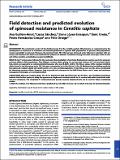Por favor, use este identificador para citar o enlazar a este item:
http://hdl.handle.net/10261/212298COMPARTIR / EXPORTAR:
 SHARE SHARE
 CORE
BASE CORE
BASE
|
|
| Visualizar otros formatos: MARC | Dublin Core | RDF | ORE | MODS | METS | DIDL | DATACITE | |

| Título: | Field detection and predicted evolution of spinosad resistance in Ceratitis capitata |
Otros títulos: | Running title: Detection and evolution of spinosad resistance | Autor: | Guillem-Amat, Ana CSIC ORCID ; Sánchez, Lucas ; López-Errasquín, Elena CSIC; Ureña, Enric CSIC; Hernández-Crespo, Pedro CSIC ORCID ; Ortego, Félix CSIC ORCID | Palabras clave: | Medfly Insecticide nAChR Evolutionary model Resistance management |
Fecha de publicación: | 19-may-2020 | Editor: | John Wiley & Sons | Citación: | Pest management science (2020) | Resumen: | BACKGROUND:The sustainable control of the Mediterranean fruit fly, Ceratitis capitata (Wiedemann), is compromised by the development of resistance to malathion and lambda‐cyhalothrin in Spanish field populations. At present, field populations remain susceptible to spinosad. However, the resistant strain JW‐100s has been obtained under laboratory selection with spinosad, and resistance has been associated to the presence of different mutations causing truncated transcripts of the α6 subunit of the nicotinic acetylcholine receptor (nAChRα6). RESULTS:A F1‐screen assay followed by the molecular characterization of surviving flies has been used to search for spinosad resistant alleles in field populations. Two different resistant alleles giving rise to truncated isoforms of Ccα6 have been identified, which corresponds to an estimated allelic frequency of at least 0.0023‐0.0046. The fitness values of the resistant nAChRα6 alleles found in the laboratory strain JW‐100s were estimated and resulted 0.4 for RR and 0.2 for SR . Mathematical modelling predicted that spinosad resistant alleles will rapidly decline over time in field populations if their fitness cost was the same than the estimated for laboratory resistant alleles. However, they are predicted to increase in the field if their fitness cost is lower and resistance management strategies are not implemented. CONLUSION:Spinosad resistant alleles have been detected in field populations for the first time. Our modelling simulations indicate that the best option to delay the appearance of spinosad resistance would be its rotation with other insecticides without cross‐resistance. The integrated F1‐screen/molecular genetic analysis presented here can be used for future monitoring studies. |
Descripción: | 9 p.-3 fig.-3 tab. | Versión del editor: | https://doi.org/10.1002/ps.5919 | URI: | http://hdl.handle.net/10261/212298 | DOI: | 10.1002/ps.5919 | ISSN: | 1526-498X | E-ISSN: | 1526-4998 |
| Aparece en las colecciones: | (CIB) Artículos |
Ficheros en este ítem:
| Fichero | Descripción | Tamaño | Formato | |
|---|---|---|---|---|
| Pest Management Science_Guillem-Amat_2020.pdf | 1,21 MB | Adobe PDF |  Visualizar/Abrir |
CORE Recommender
PubMed Central
Citations
5
checked on 10-mar-2024
SCOPUSTM
Citations
17
checked on 16-abr-2024
WEB OF SCIENCETM
Citations
13
checked on 27-feb-2024
Page view(s)
175
checked on 18-abr-2024
Download(s)
127
checked on 18-abr-2024
Google ScholarTM
Check
Altmetric
Altmetric
Artículos relacionados:
NOTA: Los ítems de Digital.CSIC están protegidos por copyright, con todos los derechos reservados, a menos que se indique lo contrario.
